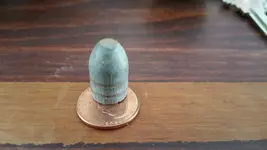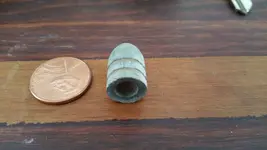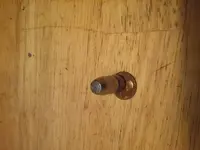You are using an out of date browser. It may not display this or other websites correctly.
You should upgrade or use an alternative browser.
You should upgrade or use an alternative browser.
What kind of bullet is this and possible age?
- Thread starter SpeMcc
- Start date
BosnMate
Gold Member
- Joined
- Sep 10, 2010
- Messages
- 6,916
- Reaction score
- 8,441
- Golden Thread
- 0
- Detector(s) used
- Whites MXT, Whites DFX, Whites 6000 Di Pro
- Primary Interest:
- Other
It has a flat nose, like it's made for use in a tubular magazine. It has cannelured grooves which makes it modern. What is the exact measurement in 1/1000 of an inch? Right now I'm guessing 50-70 or 50-90.
Upvote
0
gunsil
Silver Member
- Joined
- Dec 27, 2012
- Messages
- 3,863
- Reaction score
- 6,208
- Golden Thread
- 0
- Location
- lower hudson valley, N.Y.
- Detector(s) used
- safari, ATPro, infinium, old Garrett BFO, Excal, Nox 800
- Primary Interest:
- All Treasure Hunting
Dunno why you say flat nose means made for tubular mags. None of the bullets for my .22, 25-20, or 32-20 tube fed pump rifles are flat nosed bullets. Nor do my Winnie 30-30 or 38-55 levers with tube mags use flat nosed bullets. Also the one pictured is a fired slug so one cannot tell if it was a flat nose before firing.
Upvote
0
d2
Bronze Member
gunsil, are your pump rifles Remington model 14's and model 25's ? If so they are made so you can shoot pointed bullets in them. The purpose for the flat nose bullets or round and not pointed is for what's called a "sympathetic detonation" where the recoil from the rifle could possibly hit the primer in the shell in front of it with enough force to make it go off. I use and reload flat pointed bullets in all my older/newer lever rifles except for the model 14. .22's don't count because there is not enough recoil in those...d2
Upvote
0
gunsil
Silver Member
- Joined
- Dec 27, 2012
- Messages
- 3,863
- Reaction score
- 6,208
- Golden Thread
- 0
- Location
- lower hudson valley, N.Y.
- Detector(s) used
- safari, ATPro, infinium, old Garrett BFO, Excal, Nox 800
- Primary Interest:
- All Treasure Hunting
Been shootin' my Winnie 30-30 for over fifty years and have never seen or used a factory load with flat nosed slugs, nor have I ever heard of anybody having a shell go off in a magazine in any lever gun or pump. One is a Remy 25 32-20 (fantastic little rifles) other is an early Marlin 25-20 pump, can't recall the model, it's away in the safe. None of my rounds were ever flat nosed or pointed nosed, all round nosed factory ammo. There is no internal difference in the tube mags of these model 25s than any other tube mag rifle to compensate for pointed or round nosed bullets.
Upvote
0
BosnMate
Gold Member
- Joined
- Sep 10, 2010
- Messages
- 6,916
- Reaction score
- 8,441
- Golden Thread
- 0
- Detector(s) used
- Whites MXT, Whites DFX, Whites 6000 Di Pro
- Primary Interest:
- Other
I'm not going to get into this argument. I've always been told to shoot flat nose in tube magazines. 30-30 Winchester silver tips are flat nose. That's what I shot in my model 94. Also had a 25-35, same deal. Local gun store had a display on the wall of a tube magazine that had a sympathetic detonation. Don't know if the guy got hurt, but it sure screwed up the gun. Because 45-70 was both the single shot and Winchester's tube magazine, there are two types of 45-70 bullets, both round nose and flat nose. If you are comfortable shooting your rifle with pointed bullets sitting on the primer of the one in front, go for it. You know those ammunition companies are over cautious anyhow, and probably don't have any idea what they are doing.
Upvote
0
TheCannonballGuy
Gold Member
- Joined
- Feb 24, 2006
- Messages
- 6,606
- Reaction score
- 13,450
- Golden Thread
- 0
- Location
- Occupied CSA (Richmond VA)
- Detector(s) used
- White's 6000, Nautilus DMC-1, Minelab
- Primary Interest:
- Relic Hunting
When I first looked at this discusssion, and the photo, I saw the "knurled cannelure" (tiny parallel ridges inside a bullet's body-groove), and knew the bullet had to be from no earlier than 1877. I thought it might be a .50-70, so I went looking for potos of 19th-Century .50-70 bullets. Turns out the .50-70 (and presumably the .50-90) bullets are longer than the poster's bullet. See the photo below, showing a .50-70 Government bulletmold, marked by the manufacturer, "Winchester 1880."
I'll continue to watch this discussion with interest, because I've never seen such a short .50-caliber bullet, and I want to know what this one is. The poster says he measured it with calipers, so I have to assume it really is a .50 bullet.
I'll continue to watch this discussion with interest, because I've never seen such a short .50-caliber bullet, and I want to know what this one is. The poster says he measured it with calipers, so I have to assume it really is a .50 bullet.
Attachments
Upvote
0
mirage83
Hero Member
- Joined
- Dec 20, 2009
- Messages
- 812
- Reaction score
- 581
- Golden Thread
- 0
- Location
- NW Georgia
- Detector(s) used
- Whites MXT, XLT
I'm not going to get into this argument. I've always been told to shoot flat nose in tube magazines. 30-30 Winchester silver tips are flat nose. That's what I shot in my model 94. Also had a 25-35, same deal. Local gun store had a display on the wall of a tube magazine that had a sympathetic detonation. Don't know if the guy got hurt, but it sure screwed up the gun. Because 45-70 was both the single shot and Winchester's tube magazine, there are two types of 45-70 bullets, both round nose and flat nose. If you are comfortable shooting your rifle with pointed bullets sitting on the primer of the one in front, go for it. You know those ammunition companies are over cautious anyhow, and probably don't have any idea what they are doing.
Rightly stated. Pointed bullets are not recommended for use in tubular magazines such as found on many if not most lever-action and pump-action rifles. Round nose should be okay, but no spire-point or other nice sharp ended bullets.
Upvote
0
Charlie P. (NY)
Gold Member
- Joined
- Feb 3, 2006
- Messages
- 13,021
- Reaction score
- 17,188
- Golden Thread
- 0
- Detector(s) used
- Minelab Musketeer Advantage Pro w/8" & 10" DD coils/Fisher F75se(Upgraded to LTD2) w/11" DD, 6.5" concentric & 9.5" NEL Sharpshooter DD coils/Sunray FX-1 Probe & F-Point/Black Widows/Rattler headphone
- Primary Interest:
- Metal Detecting
I'll continue to watch this discussion with interest, because I've never seen such a short .50-caliber bullet, and I want to know what this one is. The poster says he measured it with calipers, so I have to assume it really is a .50 bullet.
I've seen shorter: 245 gr .50 cal Buffalo "Ball-ets"

Upvote
0
ecmo
Hero Member
I tried to duplicate your photo using a 405 grain .45-70 bullet from my reloading supplies. Notice the .45 cal is the same looking diameter as yours and considerable taller. The .50 would be even larger of course. No insult intended but surely you didn't measure the length as the caliber. I think that maybe a 350 grain you have.
As for the other discussion going on in this thread, I don't want to get involved except to say the only pointed bullet made for a tubular magazine is one called leverloution which was developed for those rifles but it has a rubber pointed tip so as not to cause a chain fire upon recoil.
Don
As for the other discussion going on in this thread, I don't want to get involved except to say the only pointed bullet made for a tubular magazine is one called leverloution which was developed for those rifles but it has a rubber pointed tip so as not to cause a chain fire upon recoil.
Don
Upvote
0
BosnMate
Gold Member
- Joined
- Sep 10, 2010
- Messages
- 6,916
- Reaction score
- 8,441
- Golden Thread
- 0
- Detector(s) used
- Whites MXT, Whites DFX, Whites 6000 Di Pro
- Primary Interest:
- Other
When I first looked at this discusssion, and the photo, I saw the "knurled cannelure" (tiny parallel ridges inside a bullet's body-groove), and knew the bullet had to be from no earlier than 1877. I thought it might be a .50-70, so I went looking for potos of 19th-Century .50-70 bullets. Turns out the .50-70 (and presumably the .50-90) bullets are longer than the poster's bullet. See the photo below, showing a .50-70 Government bulletmold, marked by the manufacturer, "Winchester 1880."
I'll continue to watch this discussion with interest, because I've never seen such a short .50-caliber bullet, and I want to know what this one is. The poster says he measured it with calipers, so I have to assume it really is a .50 bullet.
Believe it or not, waaaaaay back when I was a kid, my Uncle purchased a 50-70 Springfield for .50 cents. We played with that old gun a lot, Boon, Crockett, the works. The hammer dropped so hard that we could make a huge stack of paper caps and tape them in place. The caps going off would be so loud it would ring your ears, and it was best if you shut your eyes when you pulled the trigger, because exploding caps would pepper your face. Had a lot of fun with that gun. Then as an adult I restored the rifle, was able to purchase 50-70 brass from Dixie Gun Works, and found a bullet mold just like the one you have pictured. I shot it a bit, then traded it off on some other whim, but seeing that photo of the bullet mold brought some memories back.
Upvote
0
Similar threads
- Replies
- 8
- Views
- 553
- Replies
- 5
- Views
- 694
- Replies
- 8
- Views
- 292
Users who are viewing this thread
Total: 1 (members: 0, guests: 1)







